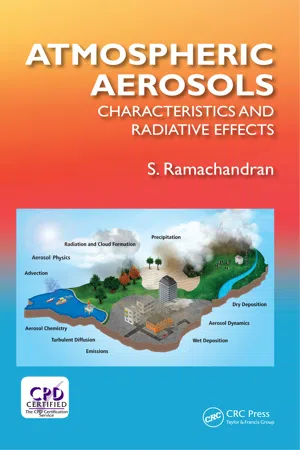
This is a test
- 276 pages
- English
- ePUB (mobile friendly)
- Available on iOS & Android
eBook - ePub
Book details
Book preview
Table of contents
Citations
About This Book
This book includes basic knowledge and understanding on the characteristics of aerosols over the continent and oceanic regions, their composition, residence times, sinks and size distributions, and their effects in the radiative transfer and climate of Earth.
Frequently asked questions
At the moment all of our mobile-responsive ePub books are available to download via the app. Most of our PDFs are also available to download and we're working on making the final remaining ones downloadable now. Learn more here.
Both plans give you full access to the library and all of Perlego’s features. The only differences are the price and subscription period: With the annual plan you’ll save around 30% compared to 12 months on the monthly plan.
We are an online textbook subscription service, where you can get access to an entire online library for less than the price of a single book per month. With over 1 million books across 1000+ topics, we’ve got you covered! Learn more here.
Look out for the read-aloud symbol on your next book to see if you can listen to it. The read-aloud tool reads text aloud for you, highlighting the text as it is being read. You can pause it, speed it up and slow it down. Learn more here.
Yes, you can access Atmospheric Aerosols by S Ramachandran in PDF and/or ePUB format, as well as other popular books in Physical Sciences & Physics. We have over one million books available in our catalogue for you to explore.
Contents
Foreword
Preface
Author
1 Climate and Aerosols
1.1 Climate System
1.2 Atmosphere
1.3 Ozone
1.4 Atmosphere and Climate
1.5 Climate, Climate Change, and Climate Variability
1.6 Aerosols
1.7 Sources and Aerosol Types
1.7.1 Sea Salt
1.7.2 Mineral Dust
1.7.3 Sulfate
1.7.4 Nitrates
1.7.5 Carbonaceous Particles
1.8 Removal Mechanisms
1.9 Production Rates and Budget
1.10 Characteristics of Ambient Aerosols
1.10.1 Continental
1.10.2 Urban
1.10.3 Rural
1.10.4 Maritime
1.10.5 Desert
1.10.6 Arctic
2 Physical, Optical, and Chemical Characteristics of Aerosols
2.1 Physical Properties
2.1.1 Size Distributions
2.1.1.1 Power Law Size Distribution
2.1.1.2 Lognormal Distribution
2.1.1.3 Gamma and Modified Gamma Distribution
2.1.1.4 Aerosol Number, Mass, Area, and Volume
2.1.2 Residence Times of Aerosols
2.2 Optical and Chemical Properties
2.2.1 Scattering
2.2.2 Mie Scattering
2.2.3 Mie Scattering of Individual and Many Particles
2.2.4 Angular Distribution of the Scattered Light Intensity of a Single Particle
2.2.5 Size Range of Aerosols for Optical Investigations
2.3 Aerosol Optical Depth, Single Scattering Albedo, and Asymmetry Parameter
2.3.1 Aerosol Optical Depth
2.3.2 Single Scattering Albedo
2.3.3 Asymmetry Parameter
2.4 Influence of Meteorology on Aerosol Characteristics
2.4.1 Atmospheric Boundary Layer
2.4.2 Temperature
2.4.3 Winds
2.4.4 Relative Humidity
2.5 Formation and Removal Processes of Aerosols
2.5.1 Aerosol Continuity Equation
2.5.1.1 Nucleation
2.5.1.2 Condensational Growth and Evaporation
2.5.1.3 Coagulation
2.5.1.4 Diffusion
2.5.1.5 Sedimentation
2.6 Aerosol Mixing and Its Impact on Aerosol Optical Properties
3 Measurements of Aerosols: Instrumentation, Techniques, and Parameters
3.1 Aerosol Mass Concentration
3.2 Aerosol Number Concentration and Size Distribution
3.3 Scattering, Absorption, and Extinction Coefficients
3.4 Chemical Composition
3.5 Scattering, Extinction Profiles of Aerosols
3.6 Aerosol Optical Depth
3.6.1 Ångström Parameters and Curvature Coefficients
3.6.1.1 Ångström Power Law
3.6.1.2 Curvature Coefficients — α1 and α2
3.6.1.3 Features of Ångstr Exponents and Curvature Coefficients
3.7 Fine Mode Fraction
3.8 Single Scattering Albedo
3.9 Asymmetry Parameter
3.10 Remote Sensing of Aerosols
3.10.1 Aerosol Extinction
3.10.2 Aerosol Optical Depth
3.10.3 Single Scattering Albedo
4 Aerosols: Radiative Transfer and Effects
4.1 Radiation
4.1.1 Radiation at the Earth’s Surface
4.2 Radiative Transfer
4.2.1 Equation
4.2.2 Beer–Lambert Law
4.2.3 Aerosols and Solar Energy Input
4.2.3.1 Effect of Surface Albedo in Radiative Transfer
4.2.4 Radiative Transfer Algorithms
4.2.5 Definition of Radiative Forcing
4.3 Aerosol Optical/Radiative Properties: Shortwave and Longwave
4.4 Aerosol Radiative Forcing
4.4.1 Estimation
4.4.2 Aerosol Radiative Forcing: Sensitivity to AOD, SSA, and g
4.4.3 Aerosol Radiative Forcing: Continent and Ocean
4.4.4 Aerosol Radiative Forcing: Role of Surface Reflectance
4.4.5 Aerosol Radiative Forcing: Shortwave versus Longwave, and Relative Humidity Dependence
4.4.6 Aerosol Radiative Forcing: Seasonal Variation
4.4.7 Aerosol Radiative Forcing: Comparison
4.5 Aerosol Radiative Forcing: Modeling Requirements
4.5.1 Equations of Motion
4.5.2 First Law of Thermodynamics
4.5.3 Continuity Equation
4.5.4 Hydrostatic Equation and Scale Height
4.5.5 Geopotential Height
4.5.6 Components of Earth-Atmosphere Climate System
4.5.7 Energy Balance Model
4.5.8 Radiative Convective Model
4.5.9 Two-Dimensional Models
4.5.10 General Circulation Model/Global Climate Model
4.5.11 Chemical Transport Model
4.6 Challenges
4.6.1 Troposphere
4.6.1.1 Natural and Man Made Fraction of Aerosols
4.6.1.2 Scattering and Absorbing Aerosols
4.6.1.3 Mixing State of Aerosols
4.6.1.4 Vertical Profiles
4.6.2 Stratosphere
4.7 Outstanding Research Issues
4.7.1 Troposphere
4.7.1.1 Measurements
4.7.1.2 Remote Sensing
4.7.1.3 Modeling
4.7.1.4 Observations and Models
4.7.2 Stratosphere
4.7.2.1 Remote Sensing and Modeling
4.7.2.2 Cirrus Clouds
5 Aerosol-Cloud Interactions and Aerosol-Climate Coupling
5.1 Clouds
5.2 Aerosol-Cloud Interactions
5.2.1 Uncertainty in Aerosol-Cloud Interactions, and Precipitation
5.3 Biogeochemical Cycling of Aerosols
5.3.1 Issues and Problems
5.4 Aerosol Deposition on Snow
5.4.1 Sources, Concentrations and Radiative Forcing of BC in Snow
5.4.2 Uncertainties and Challenges
5.5 Geoengineering
5.5.1 Benefits and Risks
6 Aerosol Impact on Atmosphere and Climate, Air Pollution, and Air Quality
6.1 Radiative Forcing
6.1.1 Direct Radiative Forcing
6.1.1.1 Tropospheric Aerosols
6.1.1.2 Black Carbon Aerosol
6.1.1.3 Aerosol Vertical Profiles and Aerosol Radiative Forcing
6.1.1.4 Curvatures in Aerosol Spectral Distribution and Radiative Forcing
6.1.1.5 Aerosol Impact on Surface Temperature
6.1.1.6 Stratosph...
Table of contents
- Cover
- Halftitle Page
- Title Page
- Copyright
- Table of Contents